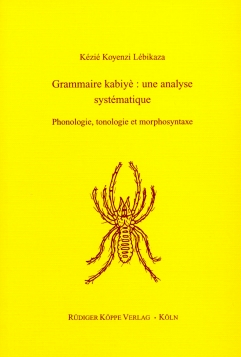
Grammaire kabiyè – une analyse systématique
Phonologie, tonologie et morphosyntaxe
Author: Kézié Koyenzi Lébikaza †. Series edited by: Wilhelm J.G. Möhlig †, Bernd Heine.
Series: GA Grammatical Analyses of African Languages Volume 11
1999559 pp.
1 map, 10 musical notations, 23 tables, numerous graphs and charts, subject index
Text language(s): French
Format: 160 x 240 mm
890 g
Paperback
€ 69.80
Buy 'Grammaire kabiyè – une analyse systématique' as a downloadable PDF document directly from our online shop »
Order 'Grammaire kabiyè – une analyse systématique' as print edition »
Kabiyè belongs to the family of Eastern Gurunsi Gur languages that are spoken in Togo, northern Ghana and northern Bénin by approx. 1 Mill. people (Ethnologue 2015). The linguist Kéziyé Koyenzi Lébikaza has written a detailed, systematic analysis of the language, which is also his mother tongue. Among other things, he discusses new aspects of Kabiyè, such as morphosyntactic and semantic problems concerning the numerical system. The author divides his work into three main chapters dealing with the phonology, the tonology and other prosodic aspects, and the morphosyntax of the language, respectively. Regarding the number of phonemes, Lébikaza adopts the early findings of Jacques Delord, who published the first systematic analysis of Kabiyè in the 1960s and 1970s. However, Lébikaza’s analysis differs concerning the phonetic representation and the phonological processes described.
In his analysis of Kabiyè tonology, he refers to the theoretical model of William Leben, in which the autosegmental and the suprasegmental theories are not mutually exclusive but complementary. After the presentation of surface tones, which are defined as the tones on the phonetic level (allotones), he defines the characteristics of L(ow) and H(igh) tonemes, and continues with a description of modulated tones, the down-step, and a detailed study of the language’s morphotonological rules.
The third and final chapter considers different word classes as well as lexical and grammatical morphemes. This allows for an analysis of morphological characteristics, of distributional and morphosyntactical word properties, and their pertinent semantic traits and syntactic functions.
Later on, further descriptions of Gur languages have been published in our series
Gur Monographs · Monographies Voltaïques
Accompanying material:
- A Grammar of Syer (Western Karaboro, Senufo)
(ISBN 978-3-89645-612-0 ) - Dictionnaire Sénoufo–Français
(ISBN 978-3-89645-115-6 ) - Grammaire kulango (parler de Bouna, Côte d’Ivoire)
(ISBN 978-3-89645-610-6 ) - L’expression de la qualification en naténi (langue gur au Bénin)
(ISBN 978-3-89645-118-7 ) - La langue pana (Burkina Faso et Mali)
(ISBN 978-3-89645-117-0 ) - Noun Class Systems in Gur Languages I + II
(ISBN 978-3-89645-619-9 )
Cross-reference:
| « back | Print version | [top] |
 Books
Books Audio
Audio Biographies
Biographies Series
Series Festschrifts
Festschrifts Journals
Journals